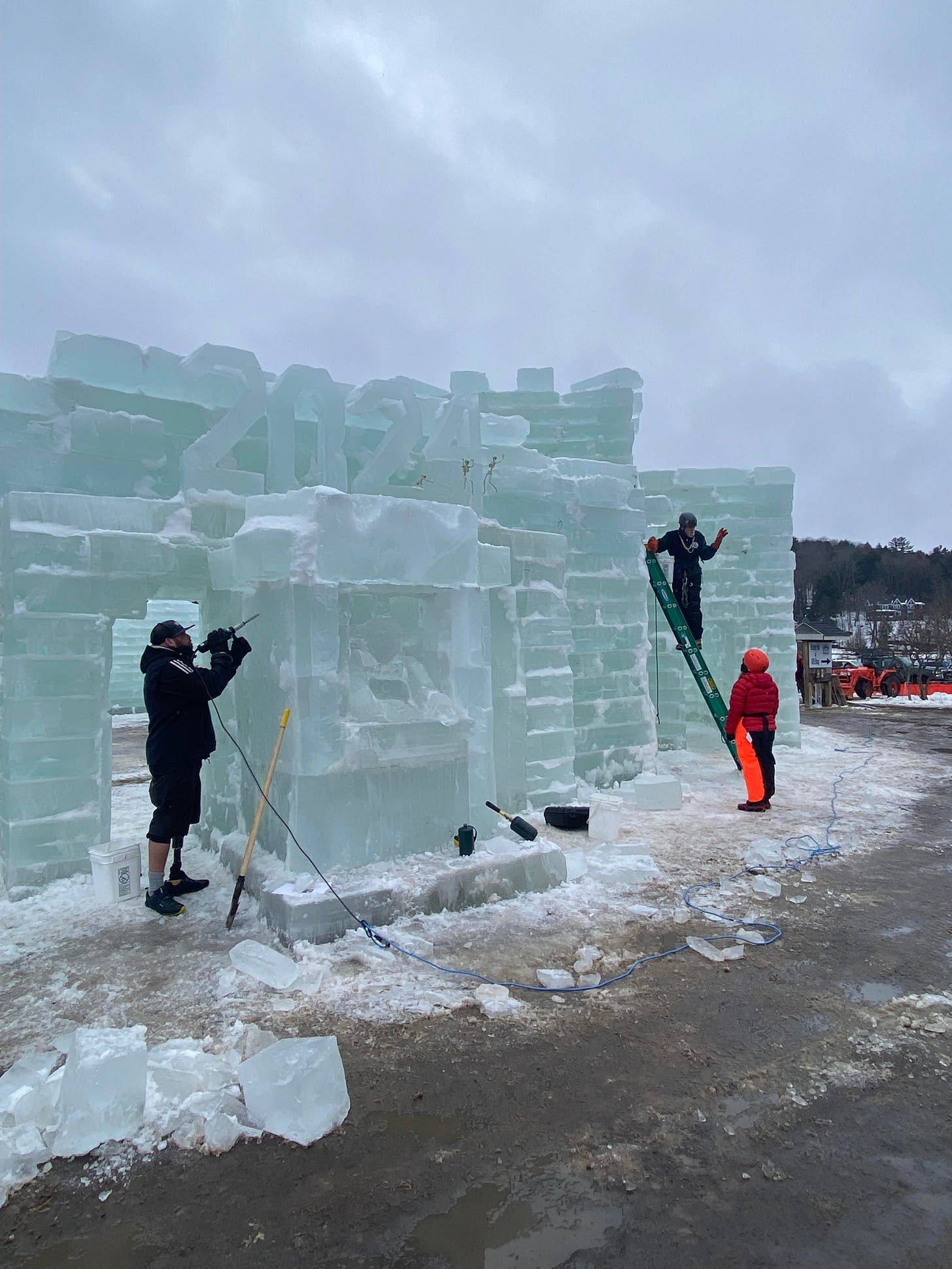We wander strange streets with Alzheimer's
Even Saranac Lake struggles for enough cold to build a castle
Bella looked at Sheriff’s Officer Casey Gordon, her face glowing.
“You have very blue eyes,” she said.
“Thank you,” he said. “My wife says so.”
We were in his little office in the county Municipal Center, getting Bella fitted with a wristband tracker provided by Operation Lifesaver, which Officer Gordon runs in Warren County. He’s a big man, probably in his 30s, who shaves the hair he has left, so his head is round and smooth.
He led us through the paperwork for the program, and showed how to assemble the device. He threaded the transmitter onto the wristband and attached it to Bella’s wrist, explaining that it is waterproof and can be kept on at all times, and a Glens Falls officer will come to the house every two months to replace the battery.
You might not think it necessary for someone like Bella, who enjoys watching TV and going out for coffee and conversing with people she meets, to take such precautions.
But before you’ve seen it, it’s hard to appreciate how fast a person’s moods can change when they have Alzheimer’s and how challenging it can be to keep them safe.
Bella was happy and cooperative with Officer Gordon, and she told him again what nice blue eyes he has, and he blushed. But at home, she sat by herself at the dining room table and frowned.
“Why do I have this?” she said, pulling at the wrist strap. “How do I get this off?”
“It’s a tracker,” I said. “So if we’re out and we get separated and I don’t know where you are, I have a way to find you.”
“But why do I have this? I’m not a child,” she said.
“No, you’re not a child. But sometimes you might get lost and not be able to find your way back home or to wherever you’re staying,” I said.
She yanked it again.
“It doesn’t come off,” I said.
“So I have to keep it on for the rest of my life?” she said.
“We can cut it off. But it gives me some peace of mind, and it gives other people peace of mind who love you,” I said. “I know you don’t like it, but I’m asking you to wear it for me.”
“I’ll do it for you,” she said.
We live in a gray zone where we often can’t understand each other. I draw on our years together to put into their places the pieces of her stories. But the disease short-circuits her attempts to communicate, fraying her connections to the past and present, the people she loves and herself.
She has moments when she beams with appreciation.
“What a beautiful child,” she’ll say then. Or, “You have a beautiful smile.”
She has been fretting and walking from room to room in the house, and when the dissatisfaction builds to a point, she goes out the door and around the neighborhood. I trail her in the car, waiting for fatigue and the weather to slow her down. Once, recently, she walked for an hour in sleeting rain.
Last weekend, we went to Boston to visit our daughter, Ginny, and her husband, Jeff, who live in Charlestown on Bunker Hill.
The change in routine and the absence of our dog, Ringo, upset Bella’s equilibrium at the end of a long day on Friday, and as we got ready for bed at about 9 p.m., she walked quickly down the hallway and out the door, through the lobby of the apartment building and out to the street.
She was still dressed, wearing a sweater and pants and sneakers, while I, chasing her, was in pajama pants, a T-shirt and slippers. It was 40 degrees, and we trudged around the hilly neighborhood for an hour and a half — her with her face set, left arm swinging, and me with arms crossed and shivering.
Now and then, she turned to look at me.
“What are you doing?” she said. “Why are you following me?”
We went down alleys and through parks and climbed two or three times to the top of the hill where the Bunker Hill monument stands.
She walked into a restaurant, crossed the dining room, strode down a narrow hallway past the kitchen, through a door marked “Employees Only” and down a rough staircase into a cellar full of boxes and wine bottles in racks.
An intoxicated woman with an open bottle in her hand came clomping after us.
“Hey,” she said, with a wave. “Get out of here.”
I tried to plan as the march continued. If I could borrow a phone from someone, I could call Ginny and Jeff. But I’d fall behind if I did that, and keeping up was the only way not to lose her.
Finally, back at the monument, her anger seemed to diminish, and she slowed down.
“We really should go back,” I said. “I’m sure Ginny and Jeff are really worried. I know the way.”
She looked at me.
“I don’t think you do,” she said.
And I don’t. I don’t know the way, because there is no way, only wandering and strange experiences. Only questions and exhaustion.
“Well, I think I do,” I said. “Let’s try this street.”
And we tried it. What else can we do?
Castles made of ice
When I was growing up in Saranac Lake, the ice castle was an awe-inspiring edifice of blocks as big as dresser drawers. Put your face up to the cold blue surface of a block and you could see green plants trapped inside. But more and more now, it’s a rush to get the palace built and a question whether it will even be possible, because of a lack of coldness.
We drove up to Saranac Lake on Thursday, where a crew of 30 or 40 volunteers was rushing to finish the castle by the start of the Winter Carnival on Friday. Looking out at the bay on Lake Flower where the blocks are cut, the ice looked barely a few inches thick. A broad swath of open water filled the middle of the lake, while, in past years, you could run out onto the ice, and motorcycle races were held in one of the bays.
This year, overnight temperatures did dip below zero a few nights in January, and the workers managed to get enough useable blocks cut to build the castle. But it was drippy on Thursday, bare dirt showing on the ground around the castle. Even in Saranac Lake, frequently the coldest spot in the lower 48, winter has been transformed over the last 50 years into a mostly mild, variable, messy season of sleet and rain and, occasionally, a bit of real cold.

Caregiver Initiative
I learned about the transmitters provided by Operation Lifesaver through the Caregiver Support Initiative, which runs programs in various counties throughout New York aimed at helping Alzheimer’s caregivers with their very challenging task. The local office is on Bay Road in Queensbury, and the phone number is 518-832-4991.






Your ongoing capacity for “being-with” Bella where she is - both mentally as well as physically- was tested beyond any limits of the imagination during your late night trip through the streets of unfamiliar territory, Will!
Yet you, and countless other caretakers of loved ones with dementia, are challenged in-the-moment, day after day, hour by hour, to react spontaneously to real or perceived safety situations, often putting your own safety at risk.
Thank you for your willingness to continue sharing your insightful personal journey, along with alerting us all to this locally available location-alert bracelet system which will hopefully continue to keep both you and Bella safe in the days and nights ahead.
God bless you both, today, tomorrow and always…
What a great idea and will most definitely help with your own peace of mind.
And they come to you to switch out batteries!
You are wonderful with Bella .
We all should have your strength , patience and resilience. World would be a better place.